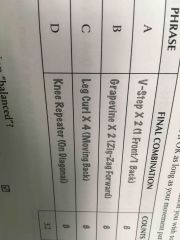![]()
![]()
![]()
Use LEFT and RIGHT arrow keys to navigate between flashcards;
Use UP and DOWN arrow keys to flip the card;
H to show hint;
A reads text to speech;
60 Cards in this Set
- Front
- Back
|
Steady state |
B |
|
|
Statement about interval training |
D |
|
|
Two bi products of aerobic exercise |
Carbon dioxide and water |
|
|
Function of right side of heart |
To deliver blood to lungs |
|
|
|
|
|
|
Oxygenated blood re enters the heart through |
Pulmonary vein |
|
|
Low fitness individuals cardio |
C |
|
|
Not a health benefit of cardio |
A |
|
|
Improve flexibility |
At the end of a workout |
|
|
borg scale |
Perceived exertion |
|
|
Lowering phase of bicep curl |
Extended |
|
|
Synovial joint |
C |
|
|
The spine cannot |
Pronate |
|
|
Leg squats improve |
Balance and muscular capacity |
|
|
Not a primary component of fitness |
Coordination |
|
|
Not specificity |
Strength training D |
|
|
Health benefit of exercise |
Increase muscle decrease fat |
|
|
Resistance training |
The ability to maintain |
|
|
Fat is used as fuel |
C low intensity |
|
|
Aneorobic exercise |
Short bursts. D |
|
|
Position during crunch |
Supine |
|
|
Burning sensation |
Lactic acid |
|
|
Downhill ski |
Aneorobic |
|
|
Primary muscle flexion |
Anterior deltoid |
|
|
Muscle responsible for abduction of scapula |
Rhomboids |
|
|
Not a pear muscle |
Rectoris pectoralis |
|
|
Slow twitch muscle fibres |
Endurance |
|
|
Strength training |
Fast twitch |
|
|
How do you modifybif you get to class late |
Limit muscle isolation |
|
|
Squat push ups are |
Multi muscle |
|
|
Instructor late |
Efficiency |
|
|
Balance and variation are examples of |
Movement patterning |
|
|
movement pattern |
Not biomechanical |
|
|
Accommodate cognitive beginners |
A |
|
|
Leg abduction Gluts |
Single row Latisimus Dorsi |
|
|
Breaking down movement patterns. Instructor should |
C |
|
|
Role of fis |
Educate motivate |
|
|
Sits |
Sub Infraspinatus Teres minor Scap |
|
|
Push ups What muscle is working eccentricly |
Pectoralis major |
|
|
What are the four dance moves |

Grapevine 2 Alternating leg curl V step 4 Knee repeater 1 |
|
|
3 Tjinfs tondo bwfire a class |
Intro Introduce Name of class Talk about components of class Reassure newcomer |
|
|
|
|
|
|
3 qualities of FIS |
Confident Outgoing Positive Entertaining
|
|
|
3 types of cueing |
Visual Auditory Kinesthetic |
|
|
3 phases of cardio |
Pre cardio. Prepare heart Cardio Cardio recovery to go back to normal |
|
|
4 benefits of cardio training |
Protect from Heart disease Strength and endurance Reduce stress Decrease resting heart rate |
|
|
Participant late. How to address why warm up is necessary |
List benefits of warm up Less chance of injury Blood flowing Prepares body |
|
|
3 primary functions of muscle conditioning class |
Muscle strength Endurance Power Functional performance |
|
|
Technique safety cues Push up |
Knees or toes Shoulders down And engaged |
|
|
Technique/safety cues Lunge |
Go wide Knees don’t go over toes |
|
|
Technique safety cues Shoulder press |
Use a weight that’s not too heavy Engage abs |
|
|
Technique safety cues crunch |
Engage core Go as far as you can |
|
|
How to modify Push up |
Toes or knees |
|
|
How to modify Lateral raise |
Extend arm elbow bend 90 degrees |
|
|
Modify crunch |
Feet on floor Feet up. Tabletop |
|
|
What do you say to someone who slips cool down |
Lactic acid releases Go back to homeostasis |
|
|
3 ways to vary range of motion |
Lever lengthen shorten Plane forward sideways Direction shifting the axis of the body |
|
|
Difference between coaching and cueing |
Coaching sharing knowledge and guiding others through an experience Cueing enables participants to follow movements through visual, auditory or kinesthetic indications made by the instructor. |
|
|
What do you say at the end of class |
Thanks for coming. Pleas let me know if you have any comments or feedback. |
|
|
Sits |
Supraspinatus Infraspinatus Teres minor Subscapularis |

